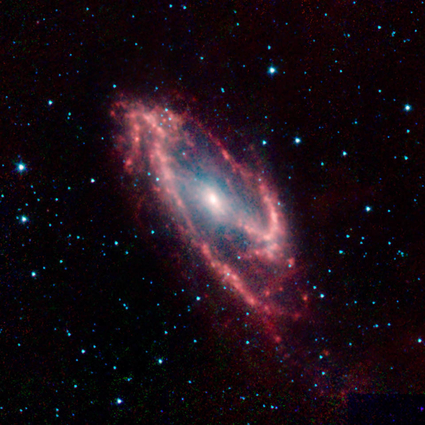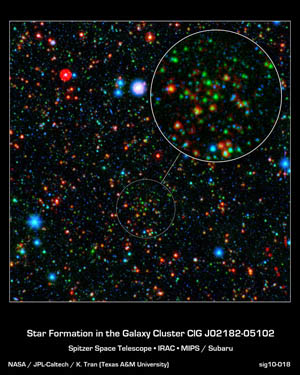To the galaxy and beyond
And now he's getting the opportunity as he and a team of collaborators have been awarded 766 hours of observing time on NASA's Spitzer Space Telescope to conduct an infrared imaging survey covering 100 square degrees of the sky.
The Spitzer Space Telescope is a space-borne observatory capable of studying objects ranging from our solar system to the distant reaches of the universe. Launched in 2003, the telescope is the final element in NASA's family of orbiting "Great Observatories," which includes the Hubble Space Telescope, the Compton Gamma-Ray Observatory and the Chandra X-Ray Observatory.
Stanford's area of study, the SPT-Spitzer Deep Field Survey, has already been studied by the South Pole Telescope in the mm-wave range, but he will be studying it in mid-infrared wavelengths, observing it with the Dark Energy Survey and in the X-ray by the XMM space telescope.
"The observing time will allow us to look at cosmology parameters like the age of the universe, and also at galaxy cluster evolution," said Stanford, an astrophysicist in the Laboratory's Institute of Geophysics and Planetary Physics.
Galaxy clusters formed in the early universe as hot gas and background radiation from the Big Bang swirled around. Cold dark matter caused the smallest structures to collapse first and eventually build the largest structures -- galaxy clusters. Clusters may contain from 10 to thousands of galaxies.
"We'll learn about the way galaxies were assembled, how they change with time and how they have grown over their evolution," Stanford said.
By observing the redshifts of the galaxy clusters, the team will be able to measure the numbers and mass of stars in the clusters. The most distant objects exhibit larger redshifts. (Redshift happens when light seen coming from an object is shifted to the red end of the spectrum, proportional to the distance).
The largest observed redshift, corresponding to the greatest distance and furthest back in time, is the cosmic microwave background radiation. It shows the state of the universe about 13.7 billion years ago, and 379,000 years after the initial moments of the Big Bang.
Stanford hopes to measure halo masses from lensing the cosmic microwave background caused by galaxy clusters, cross calibrate the three main methods of constructing galaxy cluster catalogs, and estimating galaxy cluster masses to better constrain the dark energy equation of state.
Competition for Spitzer Space Telescope time is intense. Stanford's team includes researchers from NASA-JPL, Texas A&M, National Optical Astronomy Observatory, Carnegie Mellon University, the University Chicago, Yale University, Harvard University, University of Illinois, University of Florida and Caltech, as well as researchers in Canada, France and Germany.
"I started this process (to get a large program approved on Spitzer) 10 years ago and I finally have a chance to do it -- it's very gratifying," Stanford said.






